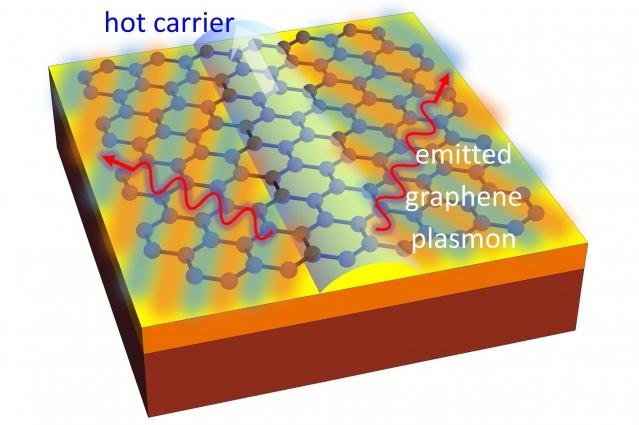New research suggests electrons can break the light barrier in graphene and produce an "optical boom," sending out a shockwave of emitted light. Photo by MIT News
BOSTON, June 13 (UPI) -- Researchers have discovered a new way to create a strong and focused beam of light using graphene. The technique uses a phenomenon called an "optical boom" -- named after the auditory phenomenon known as the sonic boom, which is caused by an object like an airplane traveling faster than the speed of sound.
In this instance, the object is electricity. When electricity moves through graphene at speeds faster than light, which slows as it travels through graphene, an optical boom triggers an intense beam of light -- an optical shockwave trapped in two dimensions.
The discovery is detailed in a paper published this week in the journal Nature Communications.
Researchers first got the idea for the technique after noticing that light particles, or photons, slow down by a factor of several hundred when traveling through graphene. The slowdown put their speed close to the rate at which electrons travel through and across graphene.
"Graphene has this ability to trap light, in modes we call surface plasmons," lead study author Ido Kaminer, a postdoctoral researcher at MIT, said in a news release.
Plasmons are a theoretical particle describing the oscillations of light particles, which bounce on and just under the surface as they travel across a semiconductor.
Graphene significantly slows light particles, but electricity travels through graphene fast and easy. This allows the electrons to approach the light barrier and generate a shockwave.
Scientists say this method of producing light is more efficient, more compact and faster than other techniques. It also may be more easily tuned for specific optical applications. The research is also further proof that graphene could play a vital role in the creation of light-based circuits and quantum computers.
As of now, the optical boom is only theoretical. The study's authors are now working to make the theory a physical reality.
"I have confidence that it should be doable within one to two years," concluded co-author Marin Soljačić, professor of physics at MIT.















